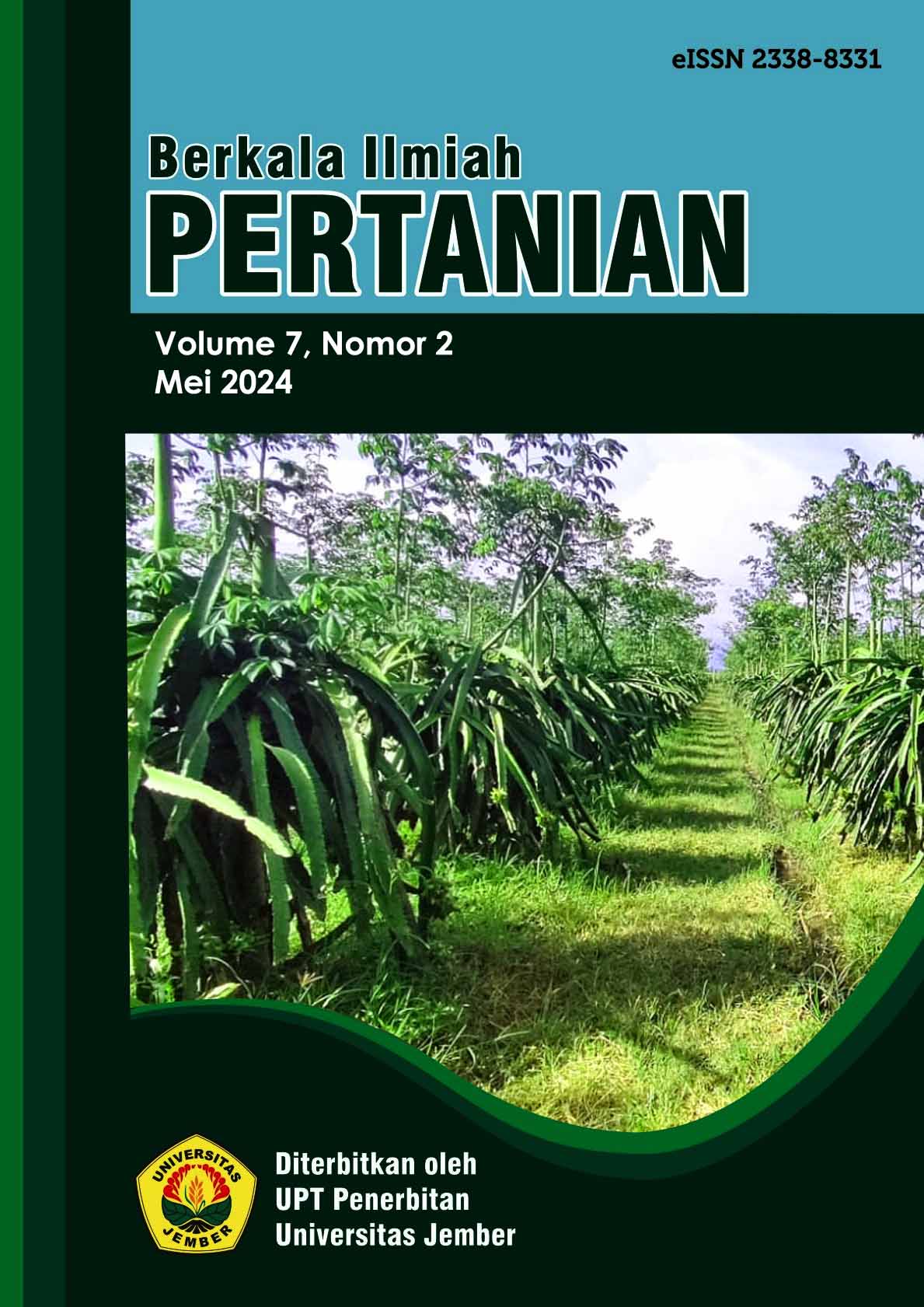Pengaruh Pemberian Pupuk Hayati Terhadap Pertumbuhan dan Hasil Tanaman Bayam Brazil (Alternanthera sissoo)
Abstract
ABSTRACT
Spinach plant production has decreased every year and the use of inorganic fertilizers is still often used by farmers. The right innovation of Brazilian spinach cultivation technique is by using biological fertilizers. This study used a non-factorial completely randomized design (CRD) with 5 treatment levels repeated 4 times, namely C0: 0 mg/plant (Control), C1: 20 mg/plant, C2: 40 mg/plant, C3: 60 mg /plant, and C4: 80 mg/plant so that there are 20 experimental treatment units. The variables used in this study were plant height, number of leaves, number of branches, leaf area, chlorophyll content, canopy area, and plant fresh weight. The data obtained were analyzed for variance (ANOVA) and further tested with Duncan's Multiple Range Test (DMRT) with a confidence level of 95%. The results showed that there was a significant effect of the application of biological fertilizers on the growth and yield of Brazilian spinach (Althernanthera sisso), namely height plants that produce the highest average value of 24.23 cm, the variable number of branches with the highest value is 6.25 branches, the variable leaf area with the highest value is 131.88 cm2, and the variable number of leaves that gives a very significant different effect with the highest value ie 11.25 strands. The correct dosage of biological fertilizers is found in the Agrice Plus fertilizer treatment with a dose of 80 mg/plant for all observed variables.
Keywords:, Brazilian Spinach, Biofertilizer
References
Badan Pusat Statistik dan Direktorat Jenderal Hortikultura. 2021. Statistik Produksi Hortikultura Tahun 2021.
Badan Pusat Statistik dan Direktorat Jenderal Hortikultura, Kementrian Pertanian.
Balai Penelitian Tanah. 2019. Pupuk Hayati. Bogor: Balai Penelitian Tanah.
Haryanto, E., T. Suhartini, E. Rahayu dan H. Sunarjano. 2013. Sawi dan Selada (Edisi Revisi). Penebar Swadaya. Jakarta. Hal. 251-267.
Jacob, A.Dan M. V. Uex Kull. 1972. Pemakaian Pupuk (Terjemahan Alauddin Tjut). Dinas Perkebunan Daerah Istimewa Aceh, Banda Aceh. 70.
Kundu, B.S. and A.C. Gaur. 1980. Establisment of Nitrogen Fixing and Phosphate Solubilizing Bacteria in Rhizosphere and their effect on yield and nutrient uptake of wheat crop. Plant Soil 57 : 223 -230.
Kurniawan, M., Izzati, M. Nurchayati, Y. 2010. Kandungan klorofil, karotenoid, dan vitamin C pada beberapa spesies tumbuhan akuatik. Buletin Anatomi dan Fisiologi XVIII (1). 28-40
Nurdin. 2018. “Penggunaan Lahan Kering di Das Limboto Provinsi Gorontalo Untuk Pertanian Berkelanjutan”. Jurnal Litbang Pertanian 30(3):98-107.
Purba, T., Tobing, O.L. and Setyono, S., 2018. Pengaruh Air Kelapa (Cocos nucifera) dan pemberian berbagai dosis Pupuk Urea Terhadap Pertumbuhan dan Produksi Tanaman Pakcoy (Brassica juncea L.). Jurnal Agronida.
Puspita, M., Laksono, R.A. and Syah, B., 2021. Respon Pertumbuhan dan Hasil Bayam Merah (Alternanthera amoena Voss.) Akibat Populasi dan Konsentrasi AB Mix pada Hidroponik Rakit Apung. Agritrop: Jurnal Ilmu-Ilmu Pertanian (Journal of Agricultural Science), 19(2); 130-145.
Raksun, A., Merta, W. dan Ilham. 2020. Pengaruh Bokashi terhadap Pertumbuhan Bayam Cabut (Amaranthus Tricolor L). J Pijar MIPA. 15(4) : 398-403.
Sari, M. N., Sudarsono dan Darmawan. 2017. Pengaruh Bahan Organik Terhadap Ketersediaan Fosfor pada Tanah-tanah Kaya Al dan Fe. Buletin Tanah Dan Lahan. 1(1) : 65–71.
Sarijan A. 2011. Analisis fisiologis tanaman jarak pada berbagai tingkat pemangkasan. Jurnal Agricola, 1(2): 153–161
Sihite, E.D. 2014. Jenis-jenis Fungi dan Pengaruh Aplikasinya terhadap Pertumbuhan Semai Avicennia marina. Skripsi Program Studi Kehutanan, Fakultas Pertanian, Universitas Sumatera Utara. Medan.
Simanungkalit RDM. 2006. Prospek Pupuk Organik dan Pupuk Hayati di Indonesia. Di dalam : Simanungkalit RDM, Suriadikarta DA, Saraswati R,Setyorini D, Hartatik W, editor : Pupuk Organik dan Pupuk Hayati. Bogor(ID) : Balai Besar Litbang Sumberdaya Lahan Pertanian, Balai Penelitiandan Pengembangan Pertanian.
Sommai, S., Cherdthong, A., Suntara, C., So, S. and Wanapat, M. 2021. In Vitro Fermentation Characteristics and Methane Mitigation Responded to Flavonoid Extract Levels from Alternanthera sissoo and Dietary Ratios. Journal Fermentatiom. 7(3) : 1–15
Sutiyoso,Y. (2003). Meramu Pupuk Hidroponik Tanaman Sayur, Tanaman Buah, Tanaman Bunga. Bogor: Penebar Swadaya.
Wakerkwa, R., Tilaar, W., dan Polii-Mandang, J. S. 2017. Aplikasi Pupuk Cair Terhadap Pertumbuhan dan Produksi Tanaman Bayam Merah (Amaranthus sp). Agri-SosioEkonomi Unsrat, 13(November), 283–294.
Zakariyya F. 2016. Menimbang Indeks Luas Daun sebagai variabel penting pertumbuhan tanaman kakao. Warta Pusat Penelitian Kopi dan Kakao Indonesia, 28(3): 8–12.

This work is licensed under a Creative Commons Attribution-NonCommercial 4.0 International License.
Authors who publish with this journal agree to the following terms:
1.Authors retain copyright and grant the journal right of first publication with the work simultaneously licensed under a Creative Commons Attribution-NonCommercial 4.0 International License that allows others to share the work with an acknowledgement of the work's authorship and initial publication in this journal.
2.Authors are able to enter into separate, additional contractual arrangements for the non-exclusive distribution of the journal's published version of the work (e.g., post it to an institutional repository or publish it in a book), with an acknowledgement of its initial publication in this journal.
3.Authors are permitted and encouraged to post their work online (e.g., in institutional repositories or on their website) prior to and during the submission process, as it can lead to productive exchanges, as well as earlier and greater citation of published work (See The Effect of Open Access).

















